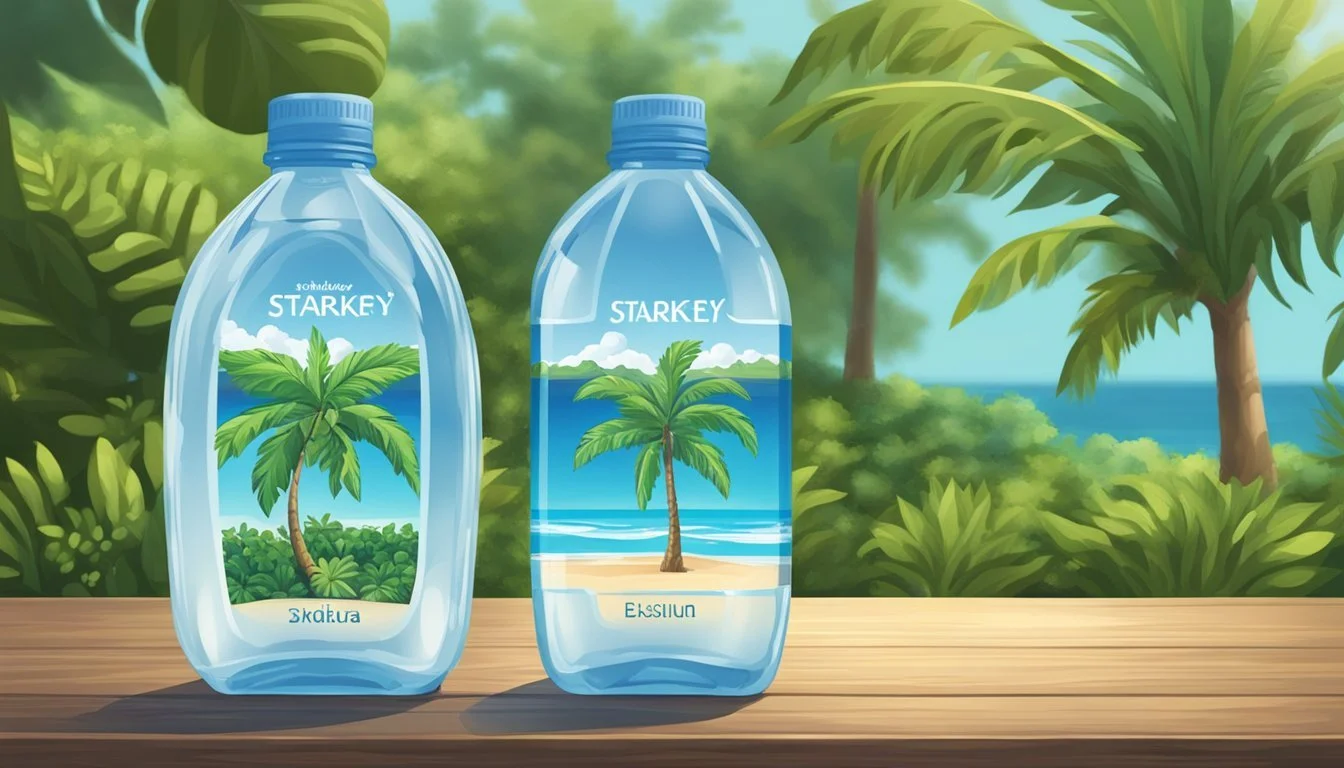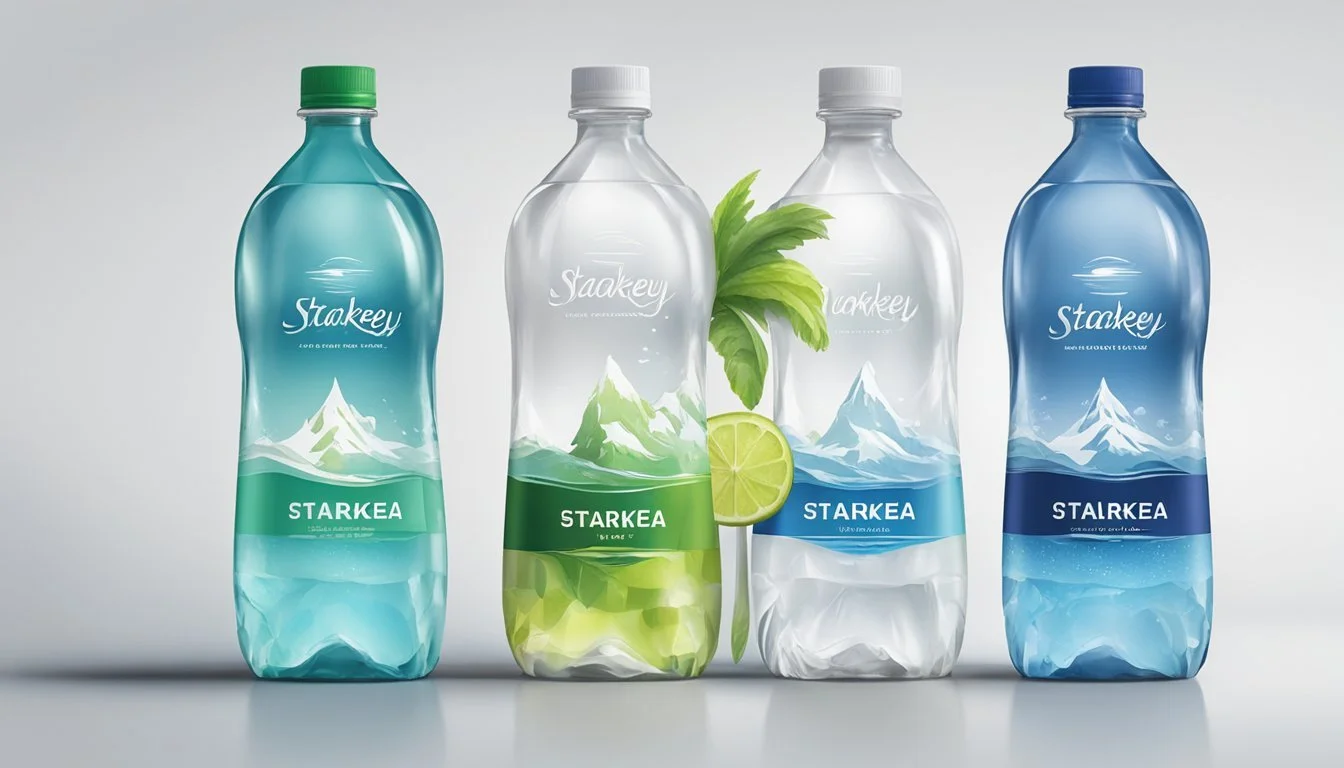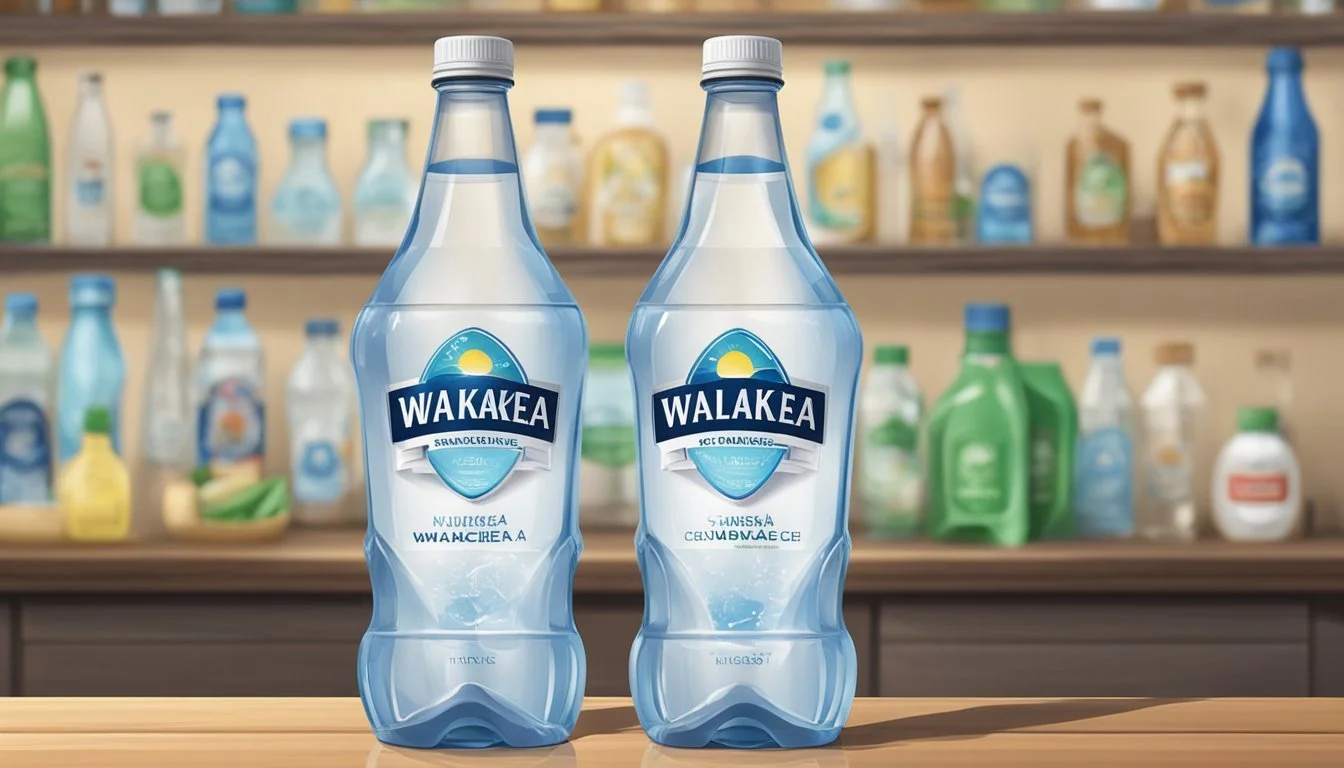Starkey vs. Waiakea
Comparing Quality and Taste
When it comes to choosing the best bottled water, many consumers debate between Starkey and Waiakea. Starkey, known for its natural spring water sourced from Idaho, offers a clean and pure taste that appeals to traditional water drinkers. On the other hand, Waiakea, sourced from the pristine springs at the base of Hawaii's Mauna Loa volcano, not only promises a refreshing taste but also emphasizes sustainability by using recycled materials for its bottles.
Starkey water boasts a naturally high pH and mineral content, which some believe can aid in better hydration and overall health. Waiakea water, enriched with naturally occurring electrolytes and minerals, offers a unique flavor profile and alkaline properties with a pH of around 8.2. This makes it not only a hydrating choice but also one that supports eco-friendly practices.
Deciding between Starkey and Waiakea often boils down to personal preferences in taste and values regarding environmental responsibility. If you prioritize sustainable practices and a distinctive flavor, Waiakea stands out as a top choice. For those seeking pure, unaltered spring water, Starkey is hard to beat. This comparison will help you determine which bottled water brand aligns best with your hydration needs and ethical considerations.
Understanding Bottled Water
Bottled water comes in various types, each with distinct properties and processes to ensure quality. Two common categories are spring water and purified water, differentiated by their source and methods of purification.
The Basics of Bottled Water
Bottled water is marketed based on different attributes like mineral content, pH levels, and source. Minerals play a key role; they can affect the taste and health benefits. For instance, mineral water contains naturally occurring minerals like calcium and magnesium.
Alkaline water has a higher pH, often marketed for its antioxidant properties and potential health benefits. Electrolytes in bottled water, such as sodium and potassium, help maintain hydration and are often added during the filtration process.
Spring Water vs. Purified Water
Spring water comes from underground sources and is collected at natural springs. It usually undergoes minimal processing to retain its natural mineral content and flavor. Natural spring water is prized for its taste, often described as crisp and refreshing due to these retained minerals.
Purified water, on the other hand, undergoes extensive filtration processes such as reverse osmosis to remove impurities. This results in a very pure form of water, often free from minerals unless they are reintroduced after purification. Purified water is preferred for its assured purity but lacks the natural taste of spring water.
Analyzing Water Quality
When comparing Starkey and Waiakea bottled waters, it's essential to look closely at their pH levels, mineral contents, and potential contaminants.
pH Levels and Alkalinity
Starkey water typically has a pH level of around 9.6, indicating it's highly alkaline. This can be beneficial for neutralizing acidity in the body.
Waiakea water, on the other hand, has a pH level around 8.2, making it less alkaline but still within the alkaline range. Both waters claim to offer benefits like improved hydration and acid-neutralizing properties due to their high pH levels.
Mineral Content and Health Benefits
Starkey water contains various minerals, including calcium, magnesium, and trace amounts of silica. These contribute to benefits such as bone health, muscle function, and skin elasticity.
Waiakea water stands out for its higher silica content, often touted for hair, skin, and nail health. Calcium and magnesium in both waters also support cardiovascular and bone health.
Potassium and sodium levels should also be noted, as they play critical roles in maintaining electrolyte balance.
Identifying Contaminants
Testing for contaminants like PFAS chemicals, heavy metals (e.g., arsenic, mercury), and total dissolved solids (TDS) is crucial.
Starkey water has faced scrutiny for traces of arsenic, though within federal limits.
Waiakea emphasizes its sourcing from volcanic rock, claiming a natural filtration process that reduces contaminants.
Both brands undergo regular testing to ensure safety and compliance with health standards, but discerning consumers should review recent test results for assurance.
Sourcing and Production
Both Starkey and Waiakea emphasize unique sources and meticulous processes to deliver high-quality bottled water to consumers. Starkey leverages geothermal aquifers, while Waiakea utilizes Hawaiian volcanic origins for their distinct water profiles.
The Journey from Source to Bottle
Starkey sources its water from geothermal aquifers located deep underground, often miles below the surface. This water is naturally heated by the Earth's geothermal energy, contributing to its purity and mineral content.
Waiakea draws its water from the slopes of the Mauna Loa volcano in Hawaii. The source is rain and snowmelt that filters through 14,000 feet of porous volcanic rock, which imparts a naturally alkaline pH level of around 8.8. This rigorous filtration through volcanic rock also enhances the purity and mineral composition.
Both brands ensure the water is collected sustainably. Starkey taps into its aquifers while maintaining ecological balance, and Waiakea extracts less than 0.003% of the water yielded by the volcanic slopes to not interfere with the ecosystem.
Filtration and Treatment Methods
Starkey's water undergoes minimal treatment as it is naturally pure from the geothermal source. To retain its natural minerals and pH balance, the water is subjected to light filtration and is bottled in facilities adhering to high sanitation standards.
Waiakea's water benefits from an extensive natural filtration process through volcanic rock. This process ionizes the water and boosts its mineral content naturally. Once collected, the water is bottled at a facility using 100% renewable energy and high-grade recycled plastic, ensuring the environmental footprint is minimized.
While Starkey relies on natural geothermal processes, Waiakea's approach includes both natural volcanic filtration and sustainable modern bottling practices, making distinct production methods that uphold purity and quality.
Environmental Considerations
This section examines how Starkey and Waiakea bottled water brands address sustainability, carbon footprint, and packaging choices, focusing on their impact and eco-friendly practices.
Sustainability Efforts and Impact
Starkey sources its water from protected geothermal springs, ensuring minimal environmental disruption. The brand emphasizes sustainability through its eco-conscious sourcing and operational practices.
Waiakea sources water from volcanic aquifers in Hawaii. It uses 100% recycled PET (rPET), reducing the need for new plastic production. Waiakea's efforts also extend to social responsibility, donating a portion of its revenue to global nonprofits.
Both brands aim to prioritize people and the planet, yet Waiakea holds an edge with innovative use of rPET and its carbon-neutral certification.
The Carbon Footprint of Bottled Water
Starkey has taken steps to minimize its carbon footprint through localized distribution, reducing transportation emissions. Their springs, located near bottling facilities, help in keeping transport distances short.
Waiakea stands out by being the first U.S. bottled water to achieve carbon-neutral certification. The company's approach includes efficient manufacturing processes and support for reforestation projects to offset emissions. Waiakea claims a 79% reduction in carbon emissions through its use of rPET bottles, a significant step towards reducing the overall footprint.
Packaging: Plastic vs. Glass
Starkey primarily uses glass bottles, which are BPA-free and deemed safer for health and the environment. Glass is reusable and recyclable, presenting a favorable option for those concerned about plastic waste.
Waiakea employs 100% rPET plastic bottles. While plastic is often criticized, rPET offers a more sustainable alternative—requiring less energy and water to produce compared to virgin plastic. The use of rPET helps in closing the loop in the plastic lifecycle, addressing significant environmental impacts associated with conventional plastic packaging.
In summary, while both Starkey and Waiakea make strides in eco-friendly practices, they utilize different methods to minimize their environmental footprints.
Brand Profiles
Understanding the unique attributes of Starkey and Waiakea bottled waters can help consumers decide which aligns best with their preferences and values.
Starkey: Deep From Idaho's Mountains
Starkey water is sourced from a geothermal spring in the mountains of Idaho. This natural alkaline spring water boasts a pH level of approximately 9.0, placing it in the category of alkaline bottled waters. Starkey emphasizes its natural origins and minimal processing, which helps maintain its purity and mineral content.
The branding for Starkey highlights its authenticity and connection to nature. The bottled water has a clean, crisp taste, attributed to its geothermal source. Starkey targets consumers looking for a natural alkaline option with minimal environmental impact.
Waiakea: Hawaiian Volcanic Water
Waiakea water is bottled at the source in Hawaii, sourced from a volcanic well. This water is known for its naturally alkaline properties, with a pH range of 7.6 to 8.2. The water's mineral composition includes electrolytes and essential minerals, making it a popular choice among health-conscious consumers.
Waiakea's branding focuses on sustainability and social responsibility. They were the first U.S. bottled water brand to be certified Carbon Neutral. Moreover, Waiakea donates over 5% of its revenue to nonprofits in Hawaii and worldwide. This commitment to people and the planet adds a layer of appeal for environmentally-conscious buyers.
Consumer Considerations
When choosing between Starkey and Waiakea bottled water, several factors come into play, such as taste and personal preference, health benefits, and price comparison. The following sections delve into these aspects to help consumers make an informed choice.
Taste and Personal Preference
Taste can be subjective, varying greatly among individuals. Waiakea water is known for its smooth, slightly sweet taste due to its volcanic filtration process, giving it a unique flavor profile. Starkey water, sourced from geothermal springs, offers a clean and pure taste but may have a different mouthfeel due to its mineral content.
Tap water can also vary in taste depending on the region, affecting personal preference for bottled water. Personal preference plays a significant role; some might prefer the crispness of Waiakea, while others may lean towards Starkey's distinct purity.
Health and Hydration Benefits
Waiakea water boasts a naturally high alkaline pH of 8.8, which helps neutralize body acidity and support critical functions. Its unique filtration through volcanic rock adds beneficial minerals like calcium, magnesium, and potassium, supporting bone health and offering superior hydration.
Starkey water, with its geothermal origin, contains a balanced mix of minerals, providing good hydration. Though it may not have the same high alkalinity as Waiakea, it still offers essential minerals beneficial for overall well-being. Both options are preferable over regular tap water for those seeking added health benefits.
Price Comparison and Value
Price is a major consideration for many consumers. Waiakea, known for its premium quality and eco-friendly packaging, tends to be priced higher than Starkey. Its cost reflects not only the unique source and benefits but also the brand's commitment to sustainability.
Starkey water, on the other hand, offers a more affordable option without compromising on quality. For consumers on a budget, Starkey might provide better value. While tap water remains the most cost-effective, bottled water options like Starkey and Waiakea offer added benefits and peace of mind regarding water quality.
Comparative Analysis
This section will explore the differences between Starkey and Waiakea bottled waters, focusing on taste, source, health benefits, and environmental impact. Expert opinions and recommendations will also be included for better insight.
Head-to-Head: Starkey vs. Waiakea
Source and Composition
Starkey water is sourced from a geothermal spring in Idaho. It boasts a unique mineral profile due to its volcanic origin, contributing to its slightly alkaline pH. Waiakea, on the other hand, is sourced from snowmelt and rain that filters through 14,000 feet of volcanic rock, which results in a naturally alkaline pH range of 7.6 to 8.2. Both waters claim volcanic origins but differ in their mineral compositions.
Taste and Refreshing Qualities
Taste is a personal preference, and Starkey’s water is often described as smooth with a hint of mineral richness. Waiakea offers a slightly sweet, mineral-rich taste due to its volcanic filtration process. Those who prioritize a smooth, clean taste might lean towards Starkey, while those who enjoy a sweeter, more mineralized water might prefer Waiakea.
Health Benefits
Starkey contains a range of minerals like calcium, magnesium, and silica that are beneficial to health. Waiakea also offers health benefits, with its alkaline nature being touted for neutralizing acid in the body. Additionally, Waiakea promotes enhanced hydration and may provide antioxidant properties due to its natural filtration through volcanic rock.
Environmental Impact
Waiakea emphasizes sustainability by being the first U.S. bottled water to be certified Carbon Neutral. It donates over 5% of revenue to nonprofits in Hawaii and around the world. Starkey also emphasizes sustainability, leveraging geothermal energy for its operations. However, Waiakea’s broader environmental initiatives give it an edge in terms of corporate social responsibility.
Expert Opinions and Recommendations
Water Sommeliers and Experts
Water sommeliers have given mixed reviews based on taste and mineral diversity. Some experts praise Starkey for its smooth taste and balance, ideal for those preferring a more subtle profile. Others favor Waiakea for its mineral richness and slightly sweet flavor, catering to those who enjoy more pronounced water taste.
Personal Preferences and Uses
When considering personal preferences, both Starkey and Waiakea have strong followings. Individuals looking for smooth, well-balanced water might prefer Starkey. Those seeking slightly sweet, mineral-rich water often opt for Waiakea.
Recommendations
Industry experts and nutritionists suggest choosing based on personal taste preference and health goals. Those looking for water with strong environmental credentials might lean towards Waiakea. For individuals focusing on a smooth taste with balanced mineral content, Starkey may be the better choice. Both brands offer high-quality, natural water options that stand out in the premium market.
Market Presence and Accessibility
Examining the market presence and accessibility of Starkey and Waiakea bottled water brands reveals important insights into their distribution channels and consumer preferences.
Distribution Channels and Retail Availability
Starkey and Waiakea both utilize a variety of distribution channels to reach consumers.
Starkey is prominently available in grocery stores and convenience stores across the United States. They focus on widespread availability, ensuring that their products can be easily found in major retail chains. This broad distribution strategy supports their goal of reaching a wide audience.
Waiakea, on the other hand, emphasizes its premium status by featuring in select high-end grocery stores and natural food markets. They also have a strong presence online through e-commerce platforms, making it easy for consumers to order directly. This selective availability reinforces its brand image as a premium and environmentally conscious choice.
Both brands are accessible in physical stores and online, but their strategies highlight differences in market positioning. Starkey's mass-market approach contrasts with Waiakea's niche, premium focus.
Consumer Trends and Brand Loyalty
Consumer trends and brand loyalty play crucial roles in the bottled water market.
Starkey caters to a broad demographic, attracting consumers who value accessibility and affordability. Their presence in mainstream retail channels helps them achieve high visibility and frequent impulse buys, fostering brand recognition and loyalty.
Waiakea appeals to environmentally conscious and health-oriented consumers. Their commitment to sustainability and volcanic water source from Hawaii appeals to those looking for unique hydration options. This focus on niche markets helps build a devoted customer base who are willing to pay a premium for quality and sustainability.
Brand loyalty for both Starkey and Waiakea is influenced by their distinct market strategies and consumer engagement efforts. Starkey's wide availability ensures consistent customer access, while Waiakea's specialized approach fosters a loyal, dedicated following.
Conclusion
When comparing Starkey and Waiakea bottled water, both offer unique features that cater to different consumer preferences.
Starkey is sourced from deep within the earth in Idaho. The water has a slightly alkaline pH of about 9.6, which may appeal to those seeking hydration that helps balance body acidity. Starkey emphasizes the purity and mineral content that comes from its geothermal source.
Waiakea, on the other hand, is sourced from the Mauna Loa volcano in Hawaii. It has an alkaline pH of 8.8, which can help neutralize acidity. Waiakea is carbon neutral and donates a portion of its revenue to global non-profits. The brand focuses on sustainability and the social impact of its business practices.
Key Points
Source and Origin:
Starkey: Sourced from geothermal springs in Idaho.
Waiakea: Rain and snowmelt filtered through volcanic rock in Hawaii.
pH Levels:
Starkey: pH of 9.6.
Waiakea: pH of 8.8.
Sustainability:
Starkey: Emphasizes natural purity without sustainability claims.
Waiakea: Carbon neutral and contributes to non-profits.
Both brands offer high-quality hydration with distinct advantages. The choice between Starkey and Waiakea will depend on what the consumer prioritizes, whether it's the source, pH level, or sustainability efforts. Each brand provides excellent options for staying hydrated.
More About Starkey
Icelandic Glacial vs Starkey: Which Bottled Water is Better?
Mountain Valley Spring Water vs Starkey: Which Bottled Water is Better?
Starkey vs Kirkland Signature: Which Bottled Water is Better?
Starkey vs Richard's Rainwater: Which Bottled Water is Better?
Starkey vs Whole Foods Italian Still Mineral water: Which Bottled Water is Better?








